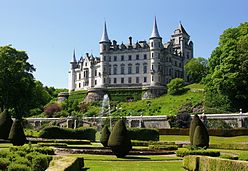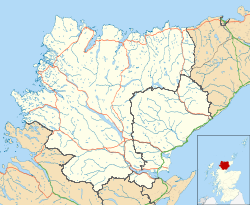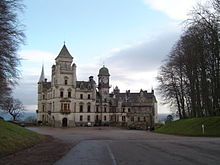- Dunrobin Castle
-
Dunrobin Castle 
East front of Dunrobin Castle and gardensLocation of Dunrobin Castle in SutherlandGeneral information Type Country house Architectural style Scottish baronial/French Renaissance Location Golspie, Highland, Scotland Coordinates 57°58′55″N 3°56′43″W / 57.981944°N 3.945278°W Completed 1845 Design and construction Client George Sutherland-Leveson-Gower, 2nd Duke of Sutherland Owner Lord Strathnaver Architect Sir Charles Barry Dunrobin Castle is a stately home in Sutherland, in the Highland area of Scotland. It is the seat of the Countess of Sutherland and the Clan Sutherland. It is located 1 mile (1.6 km) north of Golspie, and approximately 5 miles (8.0 km) south of Brora, on the Dornoch Firth close to the A9 road. Nearby Dunrobin Castle railway station, on the Far North Line was originally a private station for the castle.[1] Dunrobin's origins lie in the Middle Ages, but most of the present building is the work of Sir Charles Barry, the architect of the Palace of Westminster in London, who greatly extended the building in 1845. The resulting house has a "French Renaissance meets Scots Baronial" style. Some of the original building is visible in the interior courtyard.
Contents
History
The lands of Sutherland were acquired before 1211, by Hugh, Lord of Duffus, grandson of the Flemish nobleman, Freskin.[2] The Earldom of Sutherland was created around 1230 for Hugh's son, William, and the first record of a castle on this site dates to 1401.[3] It may have been built on the site of an early medieval fort (hence, the dun in the place-name). The earliest castle was a square keep with few, and small, windows looking out from a cliff top position, probably surrounded by a defensive curtain wall. Each floor of the keep was vaulted.[3] The Earldom passed to the Gordon family in the 16th century. In the 17th century, the keep was extended with the addition of a large house, built around a courtyard to the south-west.[3]
During the Jacobite Rising of 1745, the Jacobites under Charles Edward Stuart stormed Dunrobin Castle without warning, because the Clan Sutherland supported the British government. The 17th Earl of Sutherland, who had changed his surname from Gordon to Sutherland, narrowly escaped them, exiting through a back door.[citation needed] He sailed for Aberdeen where he joined the Duke of Cumberland's army. On the death of the 18th Earl in 1766, the house passed to his daughter, Elizabeth, who married the politician George Leveson-Gower, later created 1st Duke of Sutherland. In 1785, the house was altered and extended again.[3]
Sir Charles Barry was retained in 1845 by the 2nd Duke of Sutherland to re-model the castle completely, and to change it from a castle into a house in the "Scottish Baronial" style, which had become popular among the aristocracy. Barry had been the architect for the Palace of Westminster, home to the House of Commons, and was much in demand. The 14th-century tower, and the 17th-century and 18th-century extensions, were retained, and survive within Barry's 19th-century work.[2]
In 1915 the building was in use as a naval hospital when fire damaged much of the interior. Scottish architect Sir Robert Lorimer was engaged to renovate the house following the First World War.[2] When the 5th Duke died in 1963, the Earldom and the house went to his niece, the current Countess of Sutherland, while the Dukedom had to pass to a male heir and went to John Egerton, Earl of Ellesmere. Between 1965 and 1972, the house became a boarding school for boys. Since 1973 the house and grounds have been open to the public, with private accommodation retained for the use of the Sutherland family.[4]
Architecture
There are 189 rooms within the house, making it the largest house in the northern Highlands.[citation needed] Much of Barry's interior was destroyed by the fire in 1915. The present interiors are mainly the work of the Scottish architect Sir Robert Lorimer, although he incorporated surviving 17th-century and 18th-century work, including wood carvings attributed to Grinling Gibbons.[2] Externally, the castle has elements inspired by the work of the French architect Viollet-le-Duc, such as the pyramidal roof over the main entrance.[2] The French influence extends into the gardens. These were completed in 1850, with Barry taking inspiration for the formal parterres from the French formal style of the Gardens of Versailles.
Present use
Falconry displays are held in the castle's gardens. There also is a museum displaying the trophy heads of numerous animals shot by family members on safari; ethnographic items collected from around the world (particularly Africa); and an important collection of archaeological artifacts, collected from the enormous Sutherland estates. Notable among these are the collection of Pictish symbol stones and cross-slabs, including a majority of those discovered in Sutherland. The museum retains its Victorian-Edwardian arrangement, housed in an 18th-century summer-house adjoining the formal gardens. An exhibition includes the colours of the 93rd Sutherland Highlanders, the famous "thin red line" at Balaclava. Historically, the castle is a category A listed building,[2] and the gardens are included in the Inventory of Gardens and Designed Landscapes in Scotland.[4]
The castle is featured in the 1975 Stanley Kubrick film Barry Lyndon. It is also rumoured to be haunted.[5]
References
- ^ "Dunrobin Castle Station Waiting Room, Listed Building Report". Historic Scotland. http://hsewsf.sedsh.gov.uk/hslive/hsstart?P_HBNUM=7054. Retrieved 2009-09-15.
- ^ a b c d e f "Dunrobin Castle, Listed Building Report". Historic Scotland. http://hsewsf.sedsh.gov.uk/hslive/hsstart?P_HBNUM=7044. Retrieved 2009-09-15.
- ^ a b c d "Dunrobin Castle". CANMORE. RCAHMS. http://canmore.rcahms.gov.uk/en/site/6512/details/dunrobin+castle/. Retrieved 2009-09-15.
- ^ a b "Dunrobin Castle". An Inventory of Gardens and Designed Landscapes in Scotland. Historic Scotland. http://www.historic-scotland.gov.uk/index/heritage/gardens/gardenssearchsummary.htm?s=dunrobin&r=&bool=1&PageID=2293. Retrieved 2009-09-15.
- ^ [1]
External links
Categories:- Castles in Highland (council area)
- Clan Sutherland
- Houses in Scotland
- Renaissance Revival architecture
- Scottish baronial architecture
- Inventory of Gardens and Designed Landscapes
- Category A listed buildings in Scotland
- Listed buildings in Highland (council area)
- Listed castles in Scotland
- Leveson-Gower family
- Gardens in Highland (council area)
- Historic house museums in Highland (council area)
- Natural history museums in the United Kingdom
- Archaeology museums in Scotland
- Reportedly haunted locations in Scotland
- Country houses in Scotland
Wikimedia Foundation. 2010.



